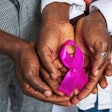Dear AuntMinnie Member,
While research continues to break ground on new, innovative imaging methods for detecting breast cancer, radiologists are also navigating how to best reach out to women about obtaining their routine mammograms.
Part of this is finding out what factors may be contributing to women not attending their mammography appointments. A team from the University of Miami found that unmet social needs are significantly tied to lower rates of screening mammography uptake, as well as linked to later-stage disease upon presentation. Find out more by accessing our coverage here.
Such outreach also means addressing health disparities present in breast cancer screening. I spoke with researchers who authored a comprehensive article outlining challenges and opportunities for breast radiologists in removing barriers for women.
Education is another aspect of patient outreach initiatives. Researchers tested an online tool for women to access and understand their breast cancer screening results. I spoke with Ram Chadalavada, MD, from the University of Cincinnati on the MyChart Mobile app and the human-centered design framework that went into the tool’s design.
It’s not just radiologists who are getting on board with patient outreach and education. A team from the University of Maryland found that ChatGPT can simplify responses to questions about breast cancer prevention and screening. The team reported that the large language model improved the reading ease and readability of educational materials while maintaining overall clinical appropriateness.
Other initiatives have shown the impact of outreach in women's imaging, such as safety net hospitals providing equitable care in breast cancer screening, a team of residents that traveled to Nepal to use point-of-care ultrasound for high-risk pregnancy cases, and representation in the National Cancer Database increasing.
Such efforts may prove to be important as breast cancer incidence increases, especially among younger women. Researchers from the Washington University in St. Louis found higher incidence rates among younger women over the past two decades. This especially goes for non-Hispanic Black women.
Are there any other examples of patient outreach initiatives in breast cancer screening that you think we should be aware of? Perhaps you're also interested in emerging breast imaging methods such as positron emission mammography or digital breast tomosynthesis. Either way, feel free to send an email along!



















